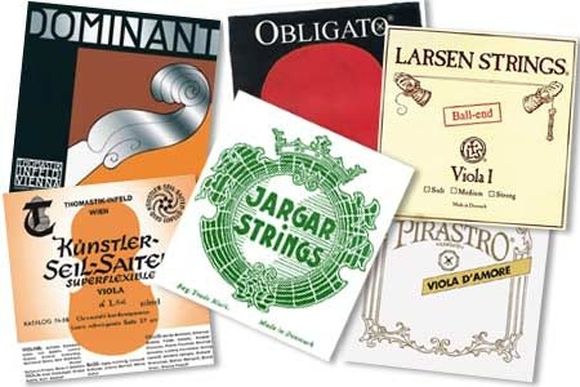6. Accessories
Strings
Most instrument shops stock a considerable range of strings. The finest are still made of natural gut, usually wound with aluminium or silver to create a smooth, durable finish - these are known as "covered gut" strings. While these strings ultimately produce the best and warmest sound, there are also a large number of covered strings available made with a synthetic core in place of the gut. Over the years, their quality has improved dramatically, and for many applications (and certainly for the beginner) they are almost the equal of their natural counterparts. In addition, they have two advantages over gut strings - they tend to last a little longer, and also settle down more quickly when newly fitted, both in terms of tuning and the sound they produce.
Strings with a wire core rather than gut or synthetic are acceptable for the beginner, but no more than that.
Fitting strings is something that should initially be done by a professional, observed by the student in order to learn how it is done. Once you have progressed to doing this at home, never forget that strings are each specific to the pitch they are tuned to (A, D, G, C - the A being the highest in pitch and the C the lowest) and are not interchangeable, so dont get them mixed up! Similarly, each string leads to a specific peg, so it's best to change strings one at a time to avoid confusion.
Rosin
Essentially a refined form of the resin produced by coniferous trees, rosin helps the hair of the bow to draw an even sound out of the string by increasing the friction between the two. There are dozens of different makes of varying quality and price, but most come as brittle blocks the colour of amber, and are wrapped in cloth or card packaging. The darker coloured versions tend to be softer and better suited to cellos and basses. It's best to handle rosin by the packaging rather than touching the block itself, as it is by nature very sticky and rather resistant to washing off the hands with soap and water. In terms of how much to apply, this is a case of "less is more" - if after playing, the belly of the viola and the stick of the bow resemble a snowy waste, then clearly far too much is being used!
Adjusters
For the beginner, adjusters (small metal fine tuners that are fixed to the tailpiece, one per string) are an excellent idea and make the job of tuning the instrument very much easier. As the student becomes more advanced, it becomes almost a matter of pride to dispense with them and learn to tune using the pegs alone. The occasional exception is the adjuster on the A string, which is sometimes retained. This is because being the highest pitched string and under greater tension, it can be rather more difficult to fine-tune effectively.
Chin & Shoulder Rests

Chin Rest
Ideally, these two accessories should be bought and chosen at the same time, as they very much work together to ensure that the player can support the instrument securely without having to "clamp down" too much with the chin, or bend the neck. Often, violas are supplied with a chin rest already fitted, but it is a mistake to assume it will necessarily be the right one for the individual. There is an enormous variety of both chin and shoulder rests available, which is fortunate given the infinite range of shapes and dimensions we humans come in. Either a teacher or a shop should help with making the right choice - something essential to achieving a good playing posture.

Shoulder Rest







